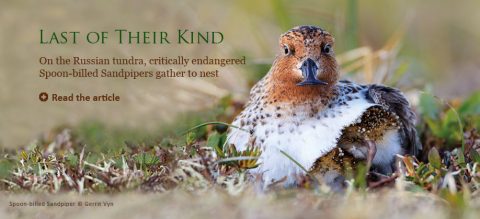A New Conservation Science Leader: Q&A with Amanda Rodewald
By Gustave Axelson
January 15, 2013

Amanda Rodewald has been hired as the new director of the Cornell Lab’s Conservation Science program, where she will oversee a staff of scientists and student researchers to provide science that informs conservation strategies and addresses critical threats to birds and biodiversity. Rodewald comes to the Lab from Ohio State University, where she was a professor of wildlife ecology. She is a Fellow of the American Ornithologists’ Union and serves on the Science Advisory Board for the Environmental Protection Agency. Rodewald begins at the Lab in February, but she talked with us recently before making the move to Sapsucker Woods.
—Gustave Axelson
Why don’t you begin by telling us what you’ve been working on at Ohio State for the past 12 years?
My students and I have been developing an approach to evaluating systems where we move beyond just describing patterns to exploring the deeper processes at work. Whether we’re doing research around urban areas like Columbus, Ohio, managed forests in the Appalachians, or coffee farms in the Andes, this approach results in a deeper understanding of what we need to do from a management perspective. One quick example, we studied mature forest birds, like Ovenbirds and Worm-eating Warblers, and their juveniles during nesting, a period of high predation and mortality (see Beyond the Empty Nest, Autumn 2011). They seemed to be very heavily using regenerating clearcuts and patches of early successional habitat. But as we did more detailed work on the survivorship and movement behavior of these birds, we found that in fact they don’t require early successional habitat, and that juveniles could improve their survival by using thickly vegetated areas, like treefall gaps in older forests. So it’s really just an approach of trying to understand at a deeper level what’s happening.
One study you were part of analyzed the plumage variation of Northern Cardinals in urban areas. What was that about?
We’d been working to try to understand the consequences of urban development, especially how exotic plants might be affecting birds. And for a lot of birds, their color comes from what they eat. In the case of the cardinals, it’s the carotenoids in their diet. We found that in rural areas, the brightness of cardinal color was a good indicator of their condition. Brighter cardinals were better quality for breeding. But in urban areas, that wasn’t true. Color didn’t indicate their condition or reproductive success. In urban areas, there’s a lot of honeysuckle. Birds that eat a large amount of honeysuckle get a lot of pigment, but they’re not in good condition because honeysuckle doesn’t have much fat and protein in it. Urban cardinals also have access to birdseed, which is nutrient-rich, but carotenoid-poor. Birds that eat seed are duller, yet they’re in better condition. So that disconnects the signal of color to condition.
Why did you decide to come to the Cornell Lab of Ornithology?
The Cornell Lab is the best place in the world to do the work that I do. What’s striking is that if you look at any program at the Lab, it stands out as world-class, whether it’s science, conservation, education, or communication, they’re all related to the same mission. Being active in all of these areas is important because decisions aren’t based on science alone. As scientists, we need to engage with people who understand the decision-making process and the larger needs of society. That understanding will help us provide better information to decision-makers, and contribute information that makes our science actionable. That’s an interesting new phrase, “actionable science.” It’s science that supports decisions and actions. Ultimately, we want all of our efforts to result in real action that protects birds and habitats. Habitat loss and degradation is the biggest threat to bird populations, and there’s no easy solution. We need to work on multiple fronts at the same time to make sure that as a society we have the information we need to make good choices. That’s why the Lab is a unique and important place, because we have people working on each of these different fronts.
Last question, what’s your favorite bird?
I honestly don’t have a favorite bird. For me, it’s more about those special moments of stillness of mind and heart when you can be there and experience a bird. Whether I’m watching a nuthatch at a bird feeder, pulling a flycatcher out of a mist net, or seeing an antpitta walking through the forest, it’s those moments of really being present with that bird. That’s my favorite.


All About Birds is a free resource
Available for everyone,
funded by donors like you









